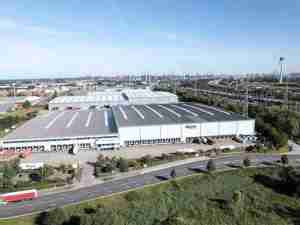Poor environmental performance in such areas is known to be scientifically correlated with higher resource depletion, global warming, and acidification. Bromma’s recent studies have confirmed the significant environmental impact of the choices port equipment manufacturers make during the port equipment production process.
Understanding the Environmental Footprint of Port Equipment in Its Production Phase
In equipment production, raw materials and energy produce steel structures such as spreaders. The associated environmental “footprint” of these activities include emissions to air, such as sulfur dioxide (SO2), nitrogen oxide (NOX), and carbon dioxide (CO2). They also include liquid emissions, such as oil and grease; how such emissions are handled during the production process can have a significant impact on groundwater systems. Finally, steel production leads to various kinds of waste, including tailings and flue gas desulfurization sludge.
In steel production, iron ore, coal, coke, water and the energy required to produce high heat are key “materials” inputs. The quality of iron ore that is sourced for steel production, and the source of energy production for the steel plant’s power grid (coal, nuclear, natural gas, hydro-electric, etc.) are major factors in determining the environmental footprint of the steel production process. A final factor is transportation cost during the steel production process – in Bromma’s case, the cost of moving steel to the Bromma spreader factory.
Two Aspects of Specifying Greener Port Equipment
In recently years ports have become much more attentive to the importance of making “green decisions” in the equipment process. At the same time, port evaluation of equipment has tended to focus almost exclusively on the “green” or “non-green” performance of equipment during its operational phase. Ports have focused on the power consumption and emissions output of container handling equipment while it is operating at the port, but little attention has been paid to the environmental impact of how the equipment is produced and the environmental “footprint” of the materials used in the equipment’s production.
Bromma’s recent study of materials used in spreaders has produced remarkable findings. The study indicates that the impact on the environment of steel produced in China is 10 times higher than that of Bromma spreader steel produced in Sweden – even when the full transportation cost to move Swedish steel from Sweden to Malaysia is included in the analysis.
The #1 factor in this huge discrepancy between Chinese steel and Swedish steel is the energy that steel factories must use in the production of steel. In China, most energy production is from coal; in Sweden most energy production is from either hydro-electric power or nuclear power. The “environmental footprint” required to generate the energy consumed in steel production is very different from “cleaner” power sources.
As Lars Meurling, Vice-President Marketing and Product Business Development at Bromma notes: “We were not surprised that there was a significant environmental difference between “clean” steel and lesser steel, but we have been quite surprised by the scale of the difference. That Swedish steel, after transport to Bromma’s factory, has 1/10th the emissions of Chinese steel, is quite remarkable, and quite encouraging. This demonstrates the importance of detailed study of the materials sourcing and production process when specifying port equipment. It also underlines the importance of taking a thorough, big picture look at what it means to embrace “green” port equipment. Many terminal operating organizations are quite genuine in th









